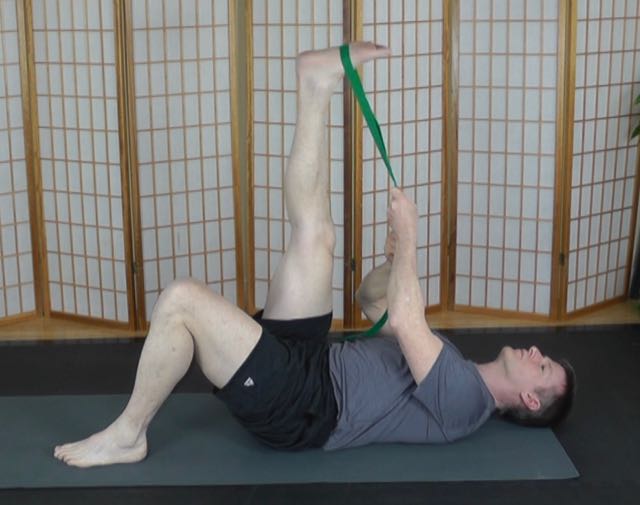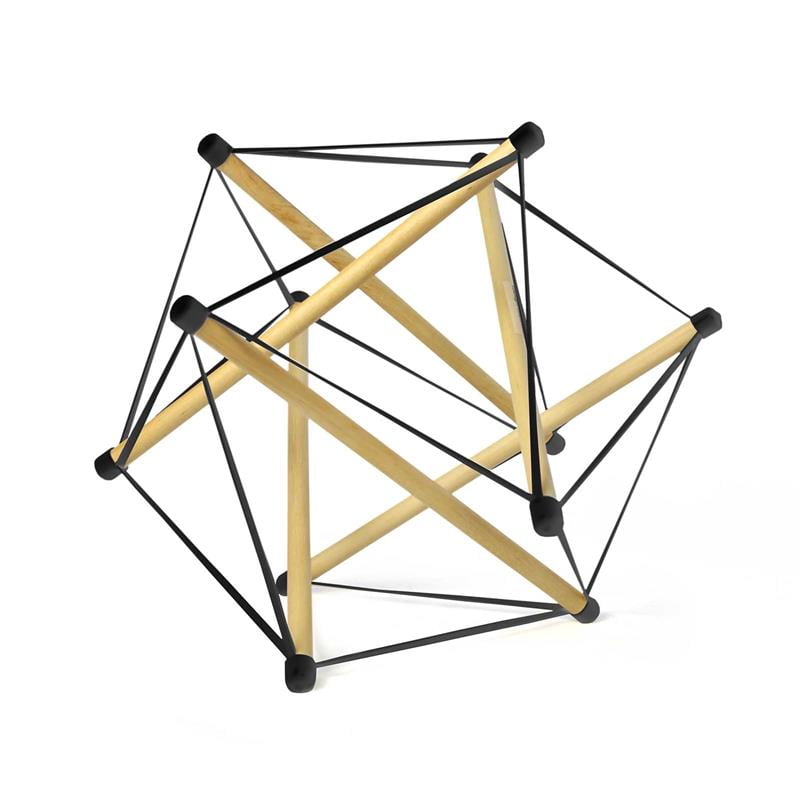Flexibility Training Program for Pain Relief and Peak Performance

The flexibility training program outlined here is based on leading edge advances in the science of stretching.
This program is designed to:
- Relieve muscular pain
- Enhance athletic performance
- Improve recovery time
- Dramatically improve range of motion, quickly and efficiently
- Achieve all of the above without strain
Following a new framework for improving flexibility, this program replaces the outdated method of stretching you learned in grade school.
Instead this program teaches the gentle but highly effective method of Active Isolated Stretching, described in detail below.
This method works perfectly for a wide range of abilities and needs. Anyone can do it, no matter if you're an athlete or completely new to working on your flexibility.
FLEXIBILITY training program using A new framework
I started to develop this framework for improving flexibility many years ago when I was first exposed to Active Isolated Stretching.
This stretching method was not only successful in helping my clients to dramatically increase flexibility, but it was also instrumental in improving outcomes for pain relief.
But as you'll see, replacing outdated stretching approaches with Active Isolated Stretching was just the first piece of the puzzle in developing this new framework.
Over the years I discovered that how we stretch requires both a different way of looking at the body and a different mindset.
In the graphic below, you'll see the Problematic Model of Stretching in the left column. This is the model most of us have grown up with.
In the right column you'll see A New Framework: The Stretching Blueprint.
The right column refers to the Stretching Blueprint for Pain Relief and Better Flexibility, my self-paced online course that developed from this new framework.
PROBLEMATIC MODEL OF STRETCHING |
A NEW framework:
|
|
↓ |
↓ |
|
Replaced by → |
|
|
Replaced by → |
|
|
Replaced by → |
|
|
Replaced by → |
|
|
Replaced by → |
|
|
Replaced by → |
|
Let's look in detail now at each section of this new model...
active isolated stretching
how it works and why it's so effective
PROBLEMATIC MODEL OF STRETCHING |
A NEW PARADIGM:
|
|
↓ |
↓ |
|
Replaced by → |
|
The foundation of the new framework is Active Isolated Stretching which offers an entirely fresh approach to improving flexibility.
But in order to understand this new method, let's first look at the old method we've all grown up with: static stretching.
the problem with static stretching
Static stretching is defined as any stretch that's held for 20-30 seconds or longer. This is how most of us learned to stretch in elementary school in gym class.
But for many us, static stretching doesn't work as well as advertised. It can feel like a struggle and can even be painful. Worse, it can fail to accomplish the goal of improving flexibility.
The problem with static stretching is that it can provoke a neurological response called the stretch reflex or protective stretch reflex. This is a natural reflex of the body designed to protect muscles from injury.
In muscles they are structures called Golgi tendons whose purpose is to constantly monitor muscle activity. When the Golgi tendons perceive a threat to the muscle, they automatically trigger a protective muscle contraction.
This protective contraction can be triggered in as few a 5 seconds while holding a muscle on a static stretch.
Once the reflex is triggered, any effort to force the stretch simply causes the protective reflex to get even stronger.
If you've ever felt your body struggling and trembling while trying to hold a static stretch then you've felt the protective stretch reflex in action.
That's why my flexibility training program does not rely on static stretching and why I use Active Isolated Stretching instead.
The Active Isolated Stretching advantage
Active Isolated Stretching resolves the problem of the protective stretch reflex with a very simple strategy:
Using a repeated 2-second stretch rather than holding the stretch.
This does NOT mean a bouncing stretch such as you may have seen. A 2-second stretch is longer than that and gives the muscle a chance to actually lengthen. You can easily achieve the correct duration by counting out loud:
One one-thousand. Two one-thousand.
Here's an example of Active Isolated Stretching as demonstrated in the Stretching Blueprint. This stretch is for the hamstrings and uses a belt or yoga strap:
(Excerpted from, Stretching Blueprint for Pain Relief and Better Flexibility: The Complete Guide to Pain-Free Muscles Using Active Isolated Stretching)
As you can see, Active Isolated Stretching uses a set number of repeated 2-second reps which gradually lengthens the muscle.
Instead of holding and waiting, struggling and wondering (as we do during a static stretch) this method offers a clear, gentle and extremely effective process.
In the video, 5 reps are demonstrated. For very tight muscles you might increase the reps to 10 or 12. For more flexible muscles or regions you might do fewer than 5.
Because this method works incrementally, it is very gentle which makes it ideal as a flexibility training program for beginners.
But Active Isolated Stretching is also the best way to increase flexibility for athletes because it is time efficient, does not induce strain and therefore improves recovery time.
For these reasons, Active Isolated Stretching has become the primary flexibility method I endorse and why it's the foundation of the Stretching Blueprint, my stretching and flexibility program.
 Stretching Blueprint for Pain Relief and Better FlexibilityThe Complete Guide to Active Isolated Stretching
|
the method and mindset of progressive ease
"less is more" for optimal results
|
Replaced by → |
|
The problem with the mindset of no pain, no gain
When attempting to improve flexibility, especially when we're also trying to relieve muscular pain, the mindset of No Pain, No Gain works against us.
This mindset is perfectly appropriate for athletic training when we're trying to push through perceived physical and mental limitations.
But when we're trying to add length and flexibility to our muscles and relieve aches and pains, this mindset runs counter to both our effort and our physiology.
Recall what we learned about the protective stretch reflex, described above in the section on static stretching: this reflex can be triggered in as few a 5 seconds when holding a static stretch.
And once triggered no amount of toughing it out will be of any use. The muscular bracing just gets worse and worse. resulting in soreness at very least. At worst, it can lead to injury.
This not only impedes the goal of improving flexibility, but can result in excessive soreness and or even injury.
And yet because the mindset of No Pain, No Gain is so entrenched in Western culture, it can be hard for many to let it go.
I definitely saw this with some of my own clients even after explaining about the hazards of the stretch reflex and even after teaching them the fundamentals of Active Isolated Stretching.
In follow-up sessions, I'd learn that some clients were cranking on the stretch as hard as possible, pushing the range of motion to the outer limit and lapsing into longer holds than the recommended 2 seconds.
It struck me that some deep part of my clients' psyches were still under the spell of No Pain, No Gain.
I realized then that I needed a decisive method for combating this entrenched mindset.
And that is how the method of Progressive Ease came to be.
the gentle power of progressive ease
Progressive Ease is both a practical method and also a shift in mindset. The idea is very simple:
While performing a repeated 2-second stretch using Active Isolated Stretching, instead of pushing to the farthest point of one's range of motion, Progressive Ease instructs to maintain a buffer zone.
By maintaining a buffer zone I mean that you don't push the stretch to outer limit of the muscle's range of motion.
Instead of going as far as you can go and pushing against that outer limit, you approach the limit without pushing into it.
By default this creates a milder stretch. This builds in the concept of ease. On its face, this might seem like it would accomplish less.But, in fact, the opposite is true.
With each subsequent rep the stretch actually progresses farther. When we maintain a buffer zone, when we maintain a feeling of ease, we're able to maximally increase range of motion without strain.
Why does this work?
Because by using a buffer zone we're able to make absolutely certain that the protective stretch reflex is not activated.
And by committing to the idea of ease we avoid overworking while accomplishing less. This helps begin to loosen the vice grip of the No Pain, No Gain mindset and replace it with a better way.
So the method of Progressive Ease has become my antidote to a wrongheaded use of No Pain, No Gain.
In combination with Active Isolated Stretching, Progressive Ease forms the practical backbone of the Stretching Blueprint.
The body as a tensegrity
Seeing beyond symptoms alone
|
Replaced by → |
|
Seeing the body as a tensegrity
Seeing the body as a tensegrity is an extremely helpful way to understand how the body works.
The term tensegrity was coined by American architect Buckminster Fuller and is a combination of two words:
Tension + Integrity = Tensegrity
Below is a tensegrity model made from wooden dowels supported by rubber bands.
 Tensegrity model using wooden dowels and rubber bands.
Tensegrity model using wooden dowels and rubber bands.If you apply pressure to any of the wooden dowels or any of the rubber bands the whole structure is affected. This is also how our bodies work: everything affects everything else.
In a very real sense, our bodies are tensegrity structures.
As an example of this, let's consider lower back pain. Often lower back pain is caused, not by a defect in the lower back itself, but because there is inflexibility elsewhere.
For example, if one or both hamstring groups are tight and inflexible, that can exert strain on the lower back.
Another example is the gluteal muscles. If one or more of the gluteal muscles are tight and inflexible, that too can exert strain on the lower back.
In these examples, if you do stretches for flexibility on the lower back alone, you might never feel any relief.
Why?
Because the root of the problem -- the tight and inflexible hamstrings and gluteal muscles -- is not being addressed.
When we are symptom-focused only, we can miss entirely the source of the problem.
I call this, chasing the pain. Chasing but never catching the pain.
Another common example is neck pain.
When our necks hurt we naturally grab at the muscles or we might try to stretch the neck in every direction. But too often these strategies don't bring relief.
That's because the root of the problem is often inflexibility in the shoulders. Tight and inflexible shoulders can significantly reduce head and neck range of motion and cause the neck muscles to overwork.
This type of interconnection can exist anywhere in the body. In order to stop chasing the pain we need to start seeing the body as a tensegrity.
how to stop chasing the pain
As we see in the examples above of lower back and neck pain, focusing on symptoms alone can potentially miss the mark entirely.
The problem many of us face is that we are often not aware of areas of tightness and inflexibility that are the root of the problem because they are not symptomatic. And this leads to chasing the pain.
In order to stop chasing the pain:
1) We first need to develop what I call tensegrity awareness, where we stop seeing the body as an assembly of isolated parts
2) We then need to identify our inflexibility from head to toe, including all areas of hidden inflexibility
And this brings us to the flexibility scoring system that is central to the Stretching Blueprint program:
The Flexibility Diagnostic
 Stretching Blueprint for Pain Relief and Better FlexibilityThe Complete Guide to Active Isolated Stretching
|
the flexibility diagnostic
comprehensive FLEXIBILITY scoring
|
Replaced by → |
|
your stretching blueprint
Your highly personalized flexibility improvement plan
|
Replaced by → |
|
as;dlkjfas;dlkfjas;ldfkjas;dlkfj
regular blueprint updating
taking the guesswork out of your flexibility improvement
|
Replaced by → |
|
Need more detail about the program? learn more here...
to get started, just click "enroll now" below
 Stretching Blueprint for Pain Relief and Better FlexibilityThe Complete Guide to Active Isolated Stretching
|
